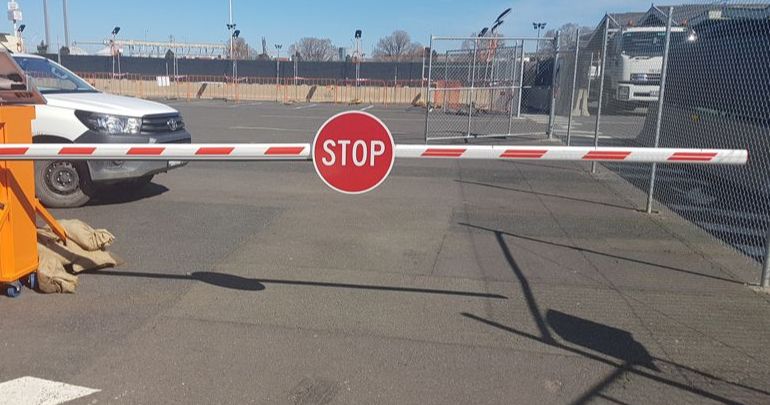Get in touch with us
Just leave your phone number with us and we’ll get back to you shortly!

Just leave your phone number with us and we’ll get back to you shortly!
Boom Barriers are emerging as an essential component when it comes to security and traffic management systems. Usually, they consist of a horizontal bar or a pole to block or permit passage. These barriers serve multiple purposes, primarily functioning as an access control system for security checkpoints in various sectors, including commercial, residential, industrial, and public spaces. They regulate vehicular movement, preventing unauthorised access while allowing controlled entry and exit.
Advanced Boom Barrier systems are important when it comes to safety and security. Some of the usages include:
Boom barriers act as a crucial deterrent against unauthorised vehicular access, ensuring that only permitted vehicles can enter specified areas. Hence they act as a crucial point in parking management systems.
These barriers are instrumental in safeguarding sensitive zones, such as government buildings, residential areas, and industrial facilities, controlling access to maintain security.
Boom barriers serve as the first line of defense in perimeter security systems, controlling access points and restricting entry to authorized personnel and vehicles.
Boom barriers efficiently manage the flow of vehicles, guiding their movement in designated directions and preventing chaotic traffic scenarios.
By controlling access and directing traffic, these barriers effectively reduce congestion and minimise the risk of accidents at entry and exit points.
Boom barriers streamline the entry and exit of vehicles, contributing to a more organised and systematic traffic flow.
Integrating automated systems with boom barriers enhances operational efficiency, allowing for seamless functioning and enhanced control.
These barriers offer cost-effective solutions for businesses and organisations by optimising traffic management and security, reducing manpower requirements, and enhancing overall operational efficiency.
There are various types of boom barriers available currently. To choose the right boom barrier and access control system, the segmentation is done in the following way:
These boom barrier gates are operated by personnel, manually lifted or lowered using physical effort. They are cost-effective as well as suitable for low-traffic locations with lower movements.
These boom barriers and access control systems are operated using remote control. Either RFIDs or movement radars can detect traffic and pedestrians, and operate accordingly. These offer more security features and can be integrated into larger systems.
Sliding Boom Barriers:
Function by sliding sideways to open or close entry points.
Commonly used in areas with limited lateral space.
Swinging Boom Barriers:
Operate by swinging inwards or outwards, creating an entry or exit path for vehicles.
Suitable for wider entry points or areas with sufficient lateral space.
Rising Arm Boom Barriers:
Vertical movement to allow or restrict vehicle access, rising or lowering as needed.
Often found at toll booths, parking lots, or checkpoints.
Boom Barriers with RFID, biometrics or remote access for enhanced security are added with surveillance systems or alarms.
Weather-resistant materials, designs to suit aesthetics, materials and sizes allowing integration with environments.
Boom Barriers are typically used as checkpoints or as parts of access control systems. But specific use case scenarios can differ at different points and places in time. Here are some of the possible use case combinations for Boom Barrier Gates, the list and applications being non-exhaustive.
Used in warehouses, factories, and industrial areas to control vehicular access.
Prevent unauthorised entry, protecting valuable assets and ensuring safety.
Regulate vehicle movement in commercial spaces, streamlining traffic flow.
Enhance safety by preventing accidental entries or unwanted vehicle access.
Housing societies uses boom barriers for controlled access at entry and exit points.
Restrict unauthorised vehicles, providing a secure living environment for residents.
Manage vehicle flow within residential areas, preventing congestion and ensuring safety.
Efficient traffic control, especially in densely populated areas.
Installed at government buildings, public areas, or sensitive facilities for security.
Manage vehicle entry, controlling access to restricted areas.
Aid in controlling traffic during events, ceremonies, or public gatherings.
Ensure orderly vehicle movement, reducing chaos and enhancing safety.
Used in parking lots to regulate vehicle entry and exit, and manage parking access.
At toll plazas, to facilitate toll collection and control vehicle passage efficiently.
Prevent unauthorised vehicles from entering, ensuring proper payment compliance in toll booths.
Facilitate orderly entry and exit in parking areas, minimising congestion and enhancing efficiency.
While there are several benefits of installing boom barriers and access control systems for security needs or managing traffic, it has several challenges ahead.
Regular maintenance, including checks and servicing, ensures proper functioning.
Dependability is crucial to prevent failures compromising security or traffic flow.
Weather resistance is vital, requiring durable materials and protective coatings.
Adaptable barriers should function optimally across diverse environmental conditions.
Installation costs vary based on barrier type and technology.
Evaluating long-term benefits, reduced risks, and enhanced efficiency helps determine ROI.
To conclude, it is important to note that while there are other options to meet specific security needs, boom barriers improve the overall flow of traffic. Innovations such as RFID Tags and biometric integration add to the security measures. Serving as the first check-point in any access control system, they offer various flexibility, when it comes to shapes and sizes. The automation has significantly reduced the time as well as human efforts required at these boom barriers.
Though toll plazas use these boom barriers, the major applications are in the commercial spaces. Park+ has revolutionised the commercial parking spaces through its tailored solutions. Visit Park+’s Business solutions and case studies to know more.
Check Our Boom Barrier in Major Cities -
Boom Barrier Dealers in Noida | Boom Barrier Suppliers in Pune | Boom Barrier in Chennai